|
Introductory Key to New Zealand Soil and Litter Invertebrates
Many invertebrates may look much alike to the untrained eye. The Key helps
with identification by pointing out distinctive
characteristics of various invertebrate groups. If you
have never used an identification key before, please read the How to use the key section.
How to use the key
Our Key is consistent
with current taxonomy, but it is not strictly taxonomic. It also
avoids technical terms or characters that require high magnification, and allows some soil animals to be identified from
photographs. For smaller animals you may need a magnifying glass or a dissecting microscope to count the legs
and to look at other characters.
To begin identification, start at the top of the table. In each pair
of characters in table rows you have to choose one, and follow
directions to another row with the next pair of characters. Repeat
this process until you come to a name. The name will take you to the description of the
group in the Guide Chapter and to the Image Gallery. Look for the picture
most similar to the animal you are examining.
|
1. Are the legs present?
|
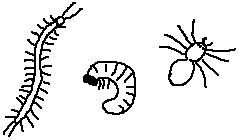
|
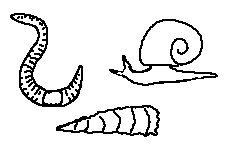
|
|
|
1a.
Legs present ........................... go to 2
|
1b.
Legs absent ..................... go to 21
|
|
2.
|

|
|
|
|
2a. Body
unsegmented, soft, velvety in appearance, with 14-16 pairs of soft stumpy legs and distinct antennae ............................ Peripatus (Onychophora)
|
2b.
Body segmented; if segmentation not apparent then all or some legs jointed ........................................ go to 3
|
|
3.
|

|
|
|
|
3a.
First 3 pairs of legs slender and jointed, the rest of the legs
soft and stubby; if soft stubby legs only, then antennae very
short .... Insect larvae (go to 29)
|
3b. All legs more or less uniform, jointed ........................................go
to 4
|
|
4. How many legs?
|
|
| |
|
4a.
9+ more pairs .... go
to 5
|
4b.
4-8 pairs ......... go to 8
|
4a.
3 pairs ......... go to 13
|
|
|
5. Are the antennae branched?
|

|
|
|
|
5a.
Antennae branched, 9 pairs of legs, small (0.5-1.5 mm), eyeless
animals, rare .................................................. Pauropoda
|
5b.
Antennae not branched, different appearance ............................... go
to 6
|
|
6.
|

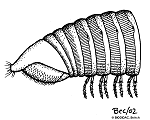
|
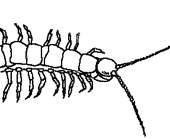
|
|
|
6a.
2 pairs of legs on each posterior body segment; body with hard
calcified cuticle, cylindrical or flattened ........... ............................... Millipedes (Diplopoda) |
6b. Only 1 pair of legs on each body segment, body soft or leathery ................................................... go
to 7
|
|
7. Look at the mouth parts underneath the head
|
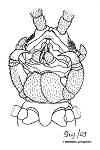

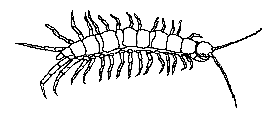
|

|
|
|
7a.
A pair of robust pincers is present underneath the
head; pale yellow to reddish-brown in colour; eyes often present;
if eyeless, then very long (30+ pairs of legs)........ Centipedes (Chilopoda) |
7b. Similar in shape, but no pincer-like appendages, no eyes,
small (3-10 mm), soft white animals with 9-12 pairs of legs ......................... Symphyla
|
|
8. Are the antennae and the head distinct?
|
|

|
|
|
8a.
Antennae and the head distinct; more than 5 pairs of legs ......................... go
to 9
|
8b.
Head fused with the thorax, 4 pairs of
walking legs + 1 pair of leg-like palps, no antennae ......... go to 10
|
|
9.
|

|
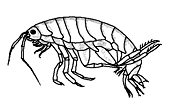
|
|
|
9a.
Body elliptical, flattened dorso-ventrally, 7 pairs of legs, legs
all similar in length ............................... Slaters (Isopoda) |
9b.
Body compressed from the sides, shrimp-like, legs of unequal
length ............ Landhoppers (Amphipoda)
|
|
10. Is there a distinct constriction (waist) behind the
last pair of legs?
|

|
|
|
|
10a. Waist present, the body is divided into two parts – the cephalothorax with
eyes and legs, and the soft abdomen with silk organs .................... Spiders (Araneae)
|
10b.
The body is globular or elongated, not divided into two parts by
constriction .........................
go to 11
|
|
11.
|
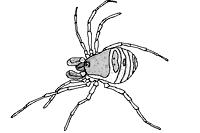
|
|
|
|
11a.
Most legs longer than the length of the body, eyes
sit close together on a tubercle in the middle of the front part
of the body ............... Harvestmen (Opiliones) |
11b.
Legs shorter than the length of the body, eyes absent (if
eyespots present, they are on the sides of the body) .......................................... go
to 12
|
|
12.
|
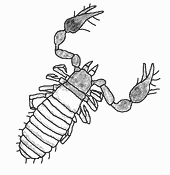
|
 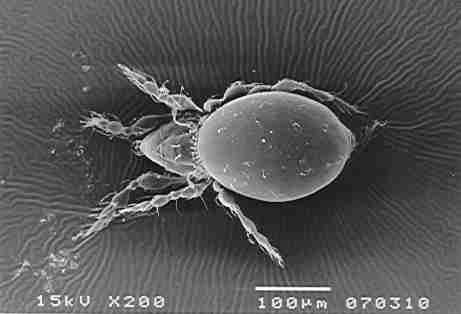
|
|
|
12a.
The front pair of appendages enlarged as pincers; ~ 5 mm in size .......... ..... False scorpions (Pseudoscorpionida)
|
12b. No large pincers, very small animals (0.1-2 mm) ...... Mites (Acari)
|
|
13.
Are antennae present?
|

|
|
|
|
13a.
Antennae completely absent (first pair of legs are often extended
forward and may be mistaken for antennae) head
small and cone-shaped; eyes absent; abdomen ending in a point. Very small
(less than 5 mm), almost colourless animals. Rare ...........................
Protura
|
13b.
Different set of characters. Antennae present (may be very short) ....................................................
go to 14
|
|
|
|
|
|
14. Is the abdomen ending with pincers?
|
14a.
Abdomen ending with pincers (see the images for 15a and 15b) ........................................ go to 15
|
14b.
No pincers, but hairs, small processes, or long "tails" may be present .................................. go to 16
|
|
15.
|
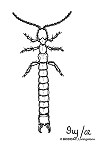
|
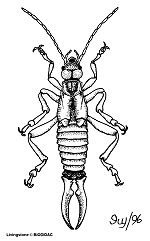
|
|
|
15a.
Eyes absent, animals white except for the darker pincers, and
always wingless ............................ Diplura (part)
|
15b.
Eyes present, animals light to dark brown; small wing covers may
be present .......... Earwigs (Insecta) |
|
|
|
|
|
16. Is the abdomen ending with long segmented “tails”?
|
16a.
Abdomen ends in 2 or 3 long (longer than ¼ length of the
abdomen), clearly segmented thin filaments ........... go to 17
|
16b.
Only short processes or hairs may be present; or the tip of the
abdomen without any processes .............................................. go
to 18
|
|
17.
|
 
|

|
|
|
17a.
Body spindle-like, with 3 long segmented filaments (“tails”)
at the end of the abdomen. Dorsal surface often covered with
hairs or scales ....Thysanura (silverfish
and bristletails) (Insecta) |
17b.
Body elongated with parallel sides, abdomen ends with 2 long
segmented processes (these are easily broken); animals white and
eyeless. Body not covered with scales ................................... Diplura (part)
|
|
18. Are the wings present in any form?
|
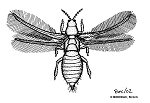 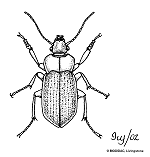 
|

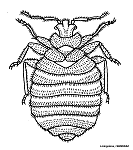

|
|
|
18a.
Wings, wing buds, or hardened wing covers present. Body clearly
separated into head, thorax and segmented abdomen; compound eyes
usually present ................ Adult insects (Insecta) |
18b.
Wings, wing buds, or hardened wing covers completely absent ................................................
go to 19
|
|
19. Look at the mouth parts
|

|

|
|
|
19a.
Mouthparts are modified into a sucking tube; body segmented, but
may be soft, rounded, and segmentation may be indistinct .................... Insects (aphids, mealy bugs, true bugs, thrips) (Insecta)
|
19b.
Mouthparts are not modified into a sucking tube; body clearly
segmented ...............................go to 20
|
|
20.
|


|
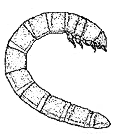  |
|
|
20a.
Body soft,
never with shields of hardened cuticle. Abdomen with 6 segments, antennae with 4-8 segments; . Forked jumping organ
often visible on the ventral side of the abdomen. If
abdominal segmentation indistinct (globular body ), then forked
spring organ always visible. Small (1-5 mm), various colours ........
Springtails (Collembola)
|
20b.
Abdomen with 7-12 segments. Body with shields of hardened cuticle, or head with distinct
hardened cover (head capsule). Forked spring
organ never present .... Insects (wingless adults or larvae) (Insecta). Go to 29 for common larvae types. |
|
21. Is the shell present?
|
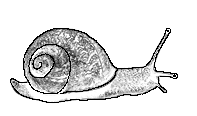
|
|
|
|
21a. shell present ..... Terrestrial
snails (Mollusca)
|
21b. shell absent .......... go to 22
|
| |
|
|
|
22.
|
22a.
Body soft, distortable, flattened or thick, not segmented ......... go to 23
|
22b.
Body long, worm-like, round in cross-section, smooth or
segmented ........ go to 25
|
|
23.
|

|
|
|
|
23a.
No tentacles, body very flattened and tapers at both ends ....... Terrestrial flatworms (Turbellaria)
|
23b.
Head with soft retractable tentacles, eyes may be visible on tips
of tentacles ....... go to 24
|
|
24. Is there a "leaf-vein" pattern on the dorsal side?
|
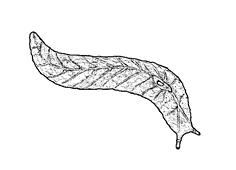
|
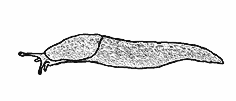
|
|
|
24a.
Body with a “leaf-vein” pattern on the dorsal
side ....... Native NZ slugs (Mollusca)
|
24b. Leaf-vein pattern absent, body with a soft “saddle” ....... Introduced
slugs (Mollusca)
|
|
25.
|

|
|
|
|
25a.
Head capsule present, or dark internal head skeleton present
(sometimes hard to see). Body in cross-section round or
flattened, always segmented, with 12 or less segments, often with
fleshy processes and hairs ........ Insect
larvae (go to 29)
|
25b. Head capsule or head skeleton absent, body round in
cross-section, long, worm-like, smooth or segmented. If
segmented, with more than 20 segments .......... go
to 26
|
|
|
|
|
|
26.
|
26a.
Body not segmented, long and very thin; body cuticle translucent .......... Nematoda |
26b.
Body segmented ....... go to 27
|
|
|
|
|
|
27.
|
27a. Very small (5-15 mm), white and somewhat transparent, fewer
segments (up to 30 or so) ...... Enchytraeidae (Oligochaeta) (pot worms)
|
27b.
Larger, body pink or brown, very numerous body segments ......... go
to 28
|
|
|
|
|
|
28. Is there a distinct saddle (clitellum) in the first half of the
body?
|
|
|
29. Common Insect larvae.
|

|
 
|
|
|
29a.
Head distinct, legs present. First 3 pairs of legs slender and
jointed, the rest of the legs soft and stubby ........ Lepidoptera (butterflies and moths) (Insecta)
|
29b.
No jointed legs; body cylindrical or flattened, sometimes with
fleshy processes. Head capsule usually indistinct (internal
mouthparts may be visible). If head distinct then the body
cylindrical, long and thin ......... Diptera (flies and
mosquitoes) (Insecta)
|
|
|


|
|
|
29c. Head distinct; usually 3 pairs of jointed legs; if legs absent then the body thick and chubby, or flattened ........ Coleoptera (beetles) (Insecta) |
|
|